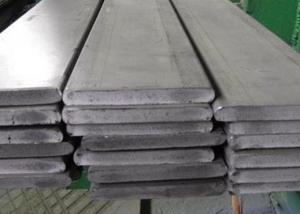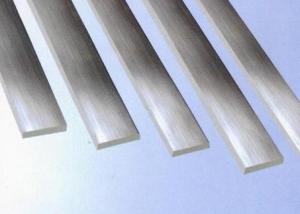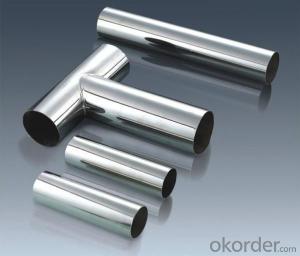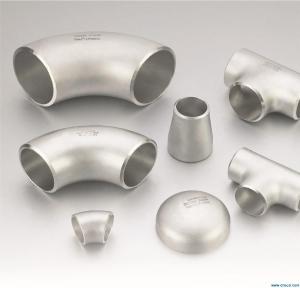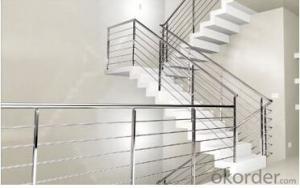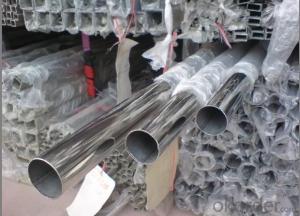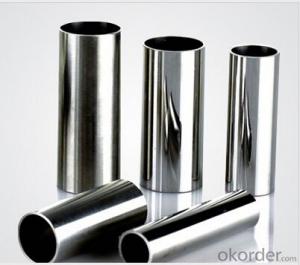STAINLESS STEEL PIPES AND FITTINGS OF 304L MATERIAL
- Loading Port:
- China Main Port
- Payment Terms:
- TT OR LC
- Min Order Qty:
- -
- Supply Capability:
- -
OKorder Service Pledge
OKorder Financial Service
You Might Also Like
Description:
Stainless Steel Pipe
Material:
304 321 316 310
Packing:
In bundle
MOQ:
5 TONS
Comparison of standardized steels
| EN-standard Steel no. k.h.s DIN | EN-standard Steel name | SAE grade | UNS |
|---|---|---|---|
| 1.4109 | X65CrMo14 | 440A | S44002 |
| 1.4112 | X90CrMoV18 | 440B | S44003 |
| 1.4125 | X105CrMo17 | 440C | S44004 |
| | | 440F | S44020 |
| 1.4016 | X6Cr17 | 430 | S43000 |
| 1.4408 | G-X 6 CrNiMo 18-10 | 316 | |
| 1.4512 | X6CrTi12 | 409 | S40900 |
| | | 410 | S41000 |
| 1.4310 | X10CrNi18-8 | 301 | S30100 |
| 1.4318 | X2CrNiN18-7 | 301LN | |
| 1.4307 | X2CrNi18-9 | 304L | S30403 |
| 1.4306 | X2CrNi19-11 | 304L | S30403 |
| 1.4311 | X2CrNiN18-10 | 304LN | S30453 |
| 1.4301 | X5CrNi18-10 | 304 | S30400 |
| 1.4948 | X6CrNi18-11 | 304H | S30409 |
| 1.4303 | X5CrNi18-12 | 305 | S30500 |
| | X5CrNi30-9 | 312 | |
| 1.4541 | X6CrNiTi18-10 | 321 | S32100 |
| 1.4878 | X12CrNiTi18-9 | 321H | S32109 |
| 1.4404 | X2CrNiMo17-12-2 | 316L | S31603 |
| 1.4401 | X5CrNiMo17-12-2 | 316 | S31600 |
| 1.4406 | X2CrNiMoN17-12-2 | 316LN | S31653 |
| 1.4432 | X2CrNiMo17-12-3 | 316L | S31603 |
| 1.4435 | X2CrNiMo18-14-3 | 316L | S31603 |
| 1.4436 | X3CrNiMo17-13-3 | 316 | S31600 |
| 1.4571 | X6CrNiMoTi17-12-2 | 316Ti | S31635 |
| 1.4429 | X2CrNiMoN17-13-3 | 316LN | S31653 |
| 1.4438 | X2CrNiMo18-15-4 | 317L | S31703 |
| 1.4362 | X2CrNi23-4 | 2304 | S32304 |
| 1.4462 | X2CrNiMoN22-5-3 | 2205 | S31803/S32205 |
| 1.4539 | X1NiCrMoCu25-20-5 | 904L | N08904 |
| 1.4529 | X1NiCrMoCuN25-20-7 | | N08926 |
| 1.4547 | X1CrNiMoCuN20-18-7 | 254SMO | S31254 |
Stainless steel’s resistance to corrosion and staining, low maintenance and familiar lustre make it an ideal material for many applications. There are over 150 grades of stainless steel, of which fifteen are most commonly used. The alloy is milled into coils, sheets, plates, bars, wire, and tubing to be used in cookware, cutlery, household hardware, surgical instruments, major appliances, industrial equipment (for example, in sugar refineries) and as an automotive and aerospace structural alloy and construction material in large buildings. Storage tanks and tankers used to transport orange juice and other food are often made of stainless steel, because of its corrosion resistance. This also influences its use in commercial kitchens and food processing plants, as it can be steam-cleaned and sterilized and does not need paint or other surface finishes.
Stainless steel is used for jewelry and watches with 316L being the type commonly used for such applications. It can be re-finished by any jeweler and will not oxidize or turn black.
Some firearms incorporate stainless steel components as an alternative to blued or parkerized steel. Some handgun models, such as the Smith & Wesson Model 60 and the Colt M1911 pistol, can be made entirely from stainless steel. This gives a high-luster finish similar in appearance to nickel plating. Unlike plating, the finish is not subject to flaking, peeling, wear-off from rubbing (as when repeatedly removed from a holster), or rust when scratched.
- Q: Can stainless steel pipes be buried in soil?
- Yes, stainless steel pipes can be buried in soil. Stainless steel is highly resistant to corrosion and can withstand the harsh conditions of being buried underground, making it a suitable choice for various underground applications such as drainage, sewage, and water supply systems.
- Q: How do stainless steel pipes compare to PVC-coated steel pipes?
- Stainless steel pipes and PVC-coated steel pipes have distinct differences in terms of material composition, durability, corrosion resistance, cost, and specific applications. Firstly, stainless steel pipes are made from a combination of iron and chromium, which provides excellent corrosion resistance and durability. This makes them suitable for applications in harsh environments, such as industrial settings or marine applications. On the other hand, PVC-coated steel pipes are made from steel coated with a layer of polyvinyl chloride (PVC). While PVC provides some level of corrosion resistance, it is not as durable as stainless steel and may degrade over time, especially in high-temperature or corrosive environments. In terms of durability, stainless steel pipes have a longer lifespan compared to PVC-coated steel pipes. Stainless steel is highly resistant to rust, corrosion, and chemical damage, ensuring long-term reliability. PVC-coated steel pipes, although corrosion-resistant to some extent, are more prone to damage from exposure to sunlight, extreme temperatures, or chemicals. When it comes to cost, PVC-coated steel pipes are generally more affordable compared to stainless steel pipes. This makes them a cost-effective option for applications that do not require high levels of durability or corrosion resistance. Stainless steel pipes, while more expensive upfront, offer a better return on investment due to their longer lifespan and reduced maintenance costs. The specific application also plays a crucial role in determining which type of pipe is most suitable. Stainless steel pipes are commonly used in industries such as oil and gas, chemical processing, food processing, and water treatment, where high strength, corrosion resistance, and hygiene are essential. PVC-coated steel pipes find application in areas such as underground drainage, irrigation systems, and electrical conduit, where cost-effectiveness and moderate durability are more important than extreme corrosion resistance. In summary, stainless steel pipes outperform PVC-coated steel pipes in terms of durability, corrosion resistance, and lifespan. However, PVC-coated steel pipes offer a more cost-effective solution for applications that do not require the same level of durability or corrosion resistance. Ultimately, the choice between these two types of pipes depends on the specific needs of the project, including its intended application, budget, and environmental conditions.
- Q: Can stainless steel pipes be used for wastewater pumping stations?
- Indeed, stainless steel pipes are suitable for use in wastewater pumping stations. Renowned for their durability, resistance to corrosion, and lengthy lifespan, stainless steel pipes prove to be an exceptional selection for wastewater applications. Given that wastewater pumping stations frequently handle corrosive and abrasive fluids, stainless steel pipes possess the ability to endure these harsh circumstances without deteriorating or causing contamination. Furthermore, stainless steel pipes are effortlessly cleaned and maintained, a critical feature for wastewater systems. In summary, stainless steel pipes represent a dependable and fitting choice for wastewater pumping stations.
- Q: Are stainless steel pipes more expensive than other types of pipes?
- Yes, stainless steel pipes are generally more expensive than other types of pipes. This is mainly due to the high cost of the raw materials used in the production of stainless steel, as well as the complex manufacturing processes involved. Stainless steel pipes also offer a range of advantages over other types of pipes, such as excellent resistance to corrosion, high durability, and the ability to withstand extreme temperatures. These factors contribute to their higher price point. However, the long-term benefits and superior performance of stainless steel pipes often justify the additional cost for many applications.
- Q: How do you prevent blockages in stainless steel pipes?
- To prevent blockages in stainless steel pipes, there are several measures you can take: 1. Regular cleaning: Clean the pipes on a regular basis to remove any accumulated debris or residue. This can be done using various cleaning methods such as mechanical cleaning tools or chemical cleaning solutions that are safe for stainless steel. 2. Proper disposal of waste: Ensure that you dispose of waste materials properly, avoiding dumping substances that can cause blockages, such as grease, oil, food scraps, or other solids. Use appropriate waste disposal systems or filters to trap these substances before they enter the pipes. 3. Avoid corrosive substances: Stainless steel pipes are resilient to corrosion, but exposure to certain highly corrosive substances can cause damage and blockages. Avoid using or disposing of chemicals or substances that are known to corrode stainless steel pipes. 4. Regular inspections: Conduct regular inspections of the pipes to identify any signs of blockages or potential issues. This can help in detecting problems early on and taking necessary preventive measures. 5. Proper installation: Ensure that the pipes are installed correctly, with proper alignment, support, and connections. This will help prevent the formation of blockages due to misaligned or poorly connected pipes. 6. Use strainers or filters: Install strainers or filters at the entry points of the pipes to catch any large particles or debris that can potentially block the pipes. Regularly clean or replace these strainers to maintain their effectiveness. 7. Avoid high-temperature buildup: Excessive heat can cause substances to solidify or congeal, leading to blockages. Avoid allowing substances to cool and solidify in the pipes by maintaining a suitable temperature and preventing sudden temperature changes. 8. Regular maintenance: Implement a regular maintenance schedule to keep the pipes in optimal condition. This can include activities such as flushing the pipes with hot water or using specialized cleaning solutions to remove any buildup or residue. By following these preventive measures, you can significantly reduce the chances of blockages in stainless steel pipes, ensuring their long-term functionality and minimizing the need for costly repairs or replacements.
- Q: What is the difference between Type 304 and Type 316 stainless steel pipes?
- The main difference between Type 304 and Type 316 stainless steel pipes is their composition and corrosion resistance. Type 304 is a basic chromium-nickel stainless steel with good corrosion resistance in mild environments, while Type 316 contains molybdenum, which enhances its resistance to corrosion, especially in chloride-rich environments. This makes Type 316 more suitable for applications in marine and coastal environments, as well as industries where exposure to harsh chemicals or high temperatures is common.
- Q: What is the difference between 321 and 347 stainless steel pipes?
- The main difference between 321 and 347 stainless steel pipes lies in the composition of their alloys. Both stainless steel grades are stabilized with titanium, which prevents the formation of harmful chromium carbides at high temperatures. However, 347 stainless steel contains additional columbium (niobium) which provides enhanced intergranular corrosion resistance. This makes 347 stainless steel pipes suitable for applications where exposure to high temperatures and corrosive environments is expected, such as in the petrochemical industry or in exhaust systems. On the other hand, 321 stainless steel pipes offer excellent resistance to oxidation and scaling at elevated temperatures, making them ideal for applications involving continuous high heat exposure, such as in aircraft exhaust systems or furnace parts. Overall, the choice between 321 and 347 stainless steel pipes depends on the specific requirements of the application, with 347 offering superior intergranular corrosion resistance and 321 providing better oxidation resistance.
- Q: How do you clean stainless steel pipes?
- To clean stainless steel pipes, you can start by using a mixture of warm water and mild soap to scrub the surface of the pipes with a soft cloth or sponge. Make sure to rinse well and dry thoroughly to prevent water spots or streaks. For tougher stains or buildup, you can use a stainless steel cleaner or polish specifically designed for this purpose. Always remember to follow the manufacturer's instructions and test any cleaner on a small, inconspicuous area before applying it to the entire pipe.
- Q: Are stainless steel pipes suitable for water treatment plants?
- Yes, stainless steel pipes are suitable for water treatment plants. Stainless steel is a corrosion-resistant material that can withstand the harsh conditions found in water treatment plants, including exposure to chemicals, high temperatures, and high pressure. It is highly durable and has a long lifespan, reducing the need for frequent replacements. Stainless steel pipes also have a smooth inner surface, which prevents the build-up of deposits and promotes efficient flow of water. Additionally, stainless steel is hygienic and does not leach harmful substances into the water, ensuring the quality and safety of the treated water.
- Q: Can stainless steel pipes be insulated with silicone?
- Yes, stainless steel pipes can be insulated with silicone. Silicone insulation is commonly used for its high temperature resistance and excellent thermal conductivity, making it suitable for insulating stainless steel pipes in various industrial and commercial applications. Silicone insulation helps prevent heat loss or gain, enhances energy efficiency, and provides protection against corrosion and condensation.
Send your message to us
STAINLESS STEEL PIPES AND FITTINGS OF 304L MATERIAL
- Loading Port:
- China Main Port
- Payment Terms:
- TT OR LC
- Min Order Qty:
- -
- Supply Capability:
- -
OKorder Service Pledge
OKorder Financial Service
Similar products
Hot products
Hot Searches
Related keywords













